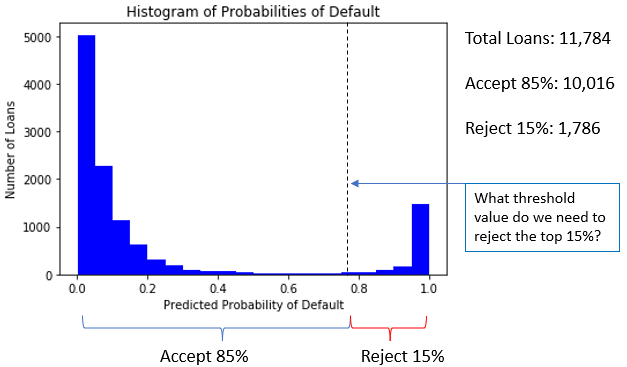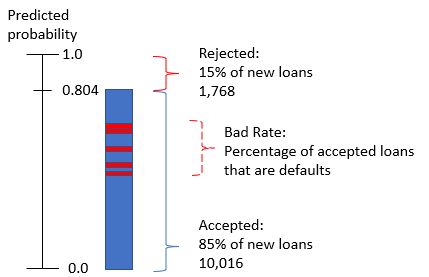Credit acceptance rates
Credit Risk Modeling in Python

Michael Crabtree
Data Scientist, Ford Motor Company
Thresholds and loan status
- Previously we set a threshold for a range of
prob_defaultvalues- This was used to change the predicted
loan_statusof the loan
- This was used to change the predicted
preds_df['loan_status'] = preds_df['prob_default'].apply(lambda x: 1 if x > 0.4 else 0)
| Loan | prob_default | threshold | loan_status |
|---|---|---|---|
| 1 | 0.25 | 0.4 | 0 |
| 2 | 0.42 | 0.4 | 1 |
| 3 | 0.75 | 0.4 | 1 |
Thresholds and acceptance rate
- Use model predictions to set better thresholds
- Can also be used to approve or deny new loans
- For all new loans, we want to deny probable defaults
- Use the test data as an example of new loans
- Acceptance rate: what percentage of new loans are accepted to keep the number of defaults in a portfolio low
- Accepted loans which are defaults have an impact similar to false negatives
Understanding acceptance rate
- Example: Accept 85% of loans with the lowest
prob_default
Calculating the threshold
- Calculate the threshold value for an 85% acceptance rate
import numpy as np
# Compute the threshold for 85% acceptance rate
threshold = np.quantile(prob_default, 0.85)
0.804
| Loan | prob_default |
Threshold | Predicted loan_status |
Accept or Reject |
|---|---|---|---|---|
| 1 | 0.65 | 0.804 | 0 | Accept |
| 2 | 0.85 | 0.804 | 1 | Reject |
Implementing the calculated threshold
- Reassign
loan_statusvalues using the new threshold
# Compute the quantile on the probabilities of default
preds_df['loan_status'] = preds_df['prob_default'].apply(lambda x: 1 if x > 0.804 else 0)
Bad Rate
- Even with a calculated threshold, some of the accepted loans will be defaults
- These are loans with
prob_defaultvalues around where our model is not well calibrated
Bad rate calculation
#Calculate the bad rate
np.sum(accepted_loans['true_loan_status']) / accepted_loans['true_loan_status'].count()
- If non-default is
0, and default is1then thesum()is the count of defaults - The
.count()of a single column is the same as the row count for the data frame
Let's practice!
Credit Risk Modeling in Python




